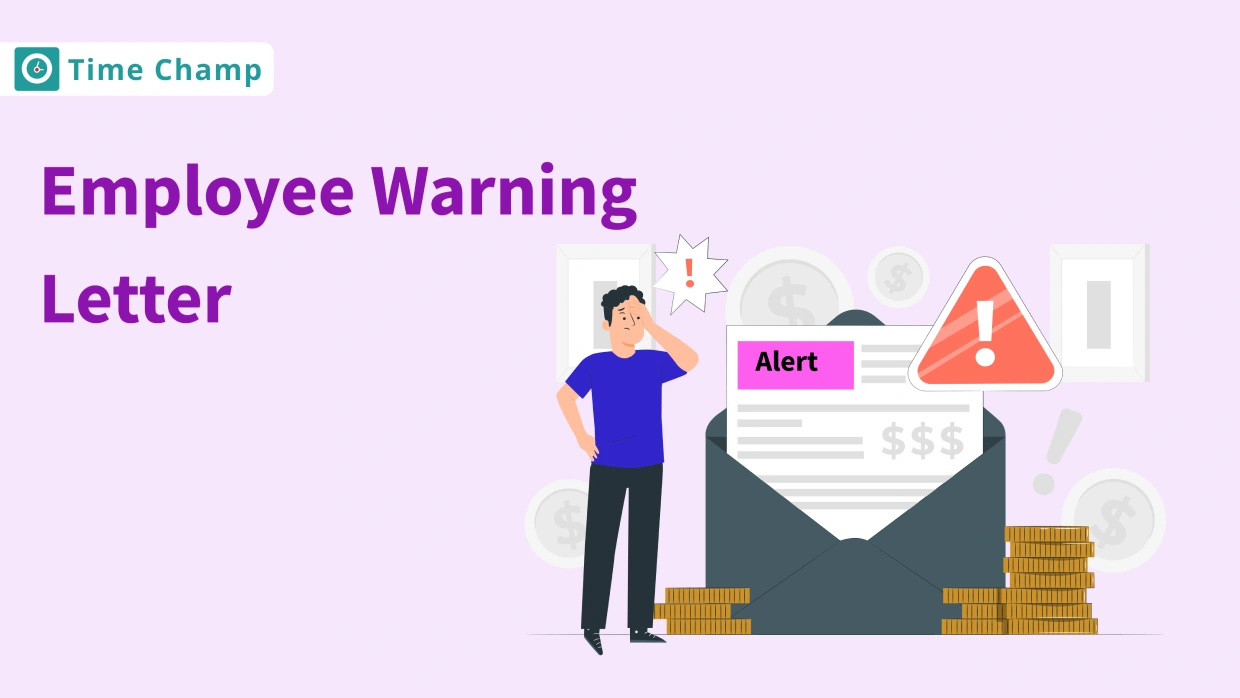Writing an employee warning letter is an important part of managing a team. It’s a formal way to tell an employee about a problem with their work or behavior and give them a chance to improve.
But writing one is indeed a difficult task, you need to convey the issue without sounding rude and then somehow still show your disappointment towards the employee’s actions.
In this guide, we’ll show you what a warning letter for employees is, what to include in a warning letter, and how to write one along with some sample templates to help you create a clear and professional letter.
What is a Warning Letter?
An employee warning letter is a formal document that an employer issues to an employee to address a specific problem related to their performance, behavior, or adherence to company policies. It’s a way to let them know that they need to do better and that their actions aren’t okay. The letter usually explains what’s wrong, gives some examples, and tells the employee what they need to do to fix it. It’s like a heads-up for the employee to shape up before things get more serious.
In a written warning, the employer and the employee both come together to discuss the problematic behavior of the employee and agree on certain measures to correct it. Here are some typical situations where an employer might issue a warning letter to an employee:
- Frequent lateness or absence
- Negligence and misconduct
- Unauthorized leaves or absence
- Insubordination
- Violation of social media policies
- Workplace violence or harassment
- Violation of company policies
- Poor performance, and so on.
How to Write an Employee Warning Letter?
Writing an employee warning letter can feel like walking a tightrope. You want to address the issue without discouraging the employee or making things feel overly formal or harsh. The goal? To help your employees improve themselves while keeping the tone respectful and constructive. Here’s how to strike that balance:
1. Be Clear and Honest About the Purpose
Start by explaining why you’re writing the letter, in a way that feels fair and professional. Instead of jumping straight to warnings, set the context:
“We’re writing this letter to address concerns about recent attendance issues. Our goal is to help you understand the expectations and how to get back on track.”
This keeps the focus on improvement, not punishment.
2. Lay Out the Facts Without Judging
Nobody likes being accused unfairly, so be sure to stick to specific incidents. Use dates, times, and patterns to illustrate the issue:
“For example, on January 3, 5, and 10, you arrived more than 20 minutes late without notifying your manager beforehand. This caused delays in team operations and impacted deadlines.”
Being factual helps avoid emotional reactions and makes the feedback easier to accept.
3. Show the Path Forward
A warning letter shouldn’t just point out what went wrong, it should also explain what can be done to fix it. Be clear and actionable:
“Going forward, we ask that you let your manager know at least an hour in advance if you’re going to be late. Additionally, using our scheduling tools can help you stay on top of your shifts.”
This shows that you’re rooting for their success and providing tools to make things better.
4. Be Honest About What Could Happen Next
Nobody likes to talk about consequences, but it’s important to be upfront about what happens if the behavior doesn’t change. However, there’s no need to sound threatening:
“If this continues, we may need to explore further action, which could include suspension or termination. We’re sharing this because we genuinely hope to avoid those steps and see positive changes instead.”
This reinforces accountability but keeps the tone empathetic.
5. End on a Positive Note
It’s easy for a warning letter to feel like the end of the road, but it doesn’t have to. End on a note of encouragement:
“We appreciate your contributions to the team and believe you can address these challenges. If there’s anything you need, whether it’s clarification, resources, or support, don’t hesitate to reach out to your manager or HR.”
This reminds the employee that the company is invested in their growth and success.
6. Make Sure Everyone’s on the Same Page
Wrap up the letter by asking the employee to acknowledge it, not to admit fault, but to confirm they understand what’s been discussed:
“Please sign below to confirm that you’ve received this letter and understand its contents. Let us know if you have any questions or need further clarity.”
This keeps things transparent and ensures everyone is aligned.
Key Points to Remember When Writing a Warning Letter for Employee
When writing a warning letter for employees, make sure you follow these points.
- Clarity and Specificity: Don’t beat around the bush, just clearly outline the problematic behavior or issue you are having with the employee, and provide specific examples and details to help the employee understand the actual concern without making them clueless about what you are talking about.
- Objectivity and Professionalism: Keep the tone of the letter professional and refrain from language that sounds blaming or harsh.
- Constructive Criticism: Do not hesitate to use good words and share helpful feedback by offering clear suggestions on how your employees can improve themselves. If needed, provide support and resources to guide them.
- Fairness and Legality: Ensure that the reasons for the warning perfectly align with your company policies and are absolutely fair. Consistency in approach is an essential right.
- Timeliness: You don’t need to wait for the right moment to issue the warning letter, issue the warning letter as soon as possible after the issue occurs to prevent further escalation of the problem.
- Documentation: “Nothing can go wrong”, this statement brings overconfidence in people and if you think the same, then it’s just your delusion, what will you do if you ever need the warning letter records in the future? That is why keeping a record of everything comes in handy, who knows, your future self might be looking for the document that you never saved.
- Consequences: People tend to take things lightly when they are unaware of the consequences, that is why you need to explain the potential outcomes if the behavior or issue is not resolved, which may include disciplinary actions, up to and including termination.
- Encouragement: Addressing the concern is fine, later do good deeds too. Conclude the letter on a positive and supportive note, express confidence in your employee’s ability to improve, and offer assistance to aid their success.
- Conciseness: While writing the employee warning letter, be sure to stick to the point and avoid making it too long. Since it’s a warning, you don’t have to delve into too many details. Simply highlight the behavior of the employee that is problematic and tell them to consider changing it. If the letter is getting too long, it is best to look towards a text summarizer. We’ve also used it quite a few times for this exact purpose.
By adhering to these key points, you can ensure that your employee warning letter is effective and helps address the issue at hand.
Also Read: Employee Termination Letter Samples
Components of a Professional Warning Letter
Make sure your warning letter covers all these components because these are the essentials.
- Date
- Employee Information
- Subject Line
- Introduction
- Issue
- Expectations
- Consequences
- Closing Remarks
5 Sample Employee Warning Letter Templates
Here are the sample Warning letter templates to give you an idea.
1. Warning Letter to Employee for Misbehavior
Subject: Formal Warning for Misconduct
[Date]
[Employee Name]
[Employee
Address]
[City, State, Zip]
Dear [Employee Name],
We are writing to address a serious concern regarding your behavior at work, which has been brought to our attention. It has come to our notice that on [date(s)], you engaged in misconduct by [describe the misconduct in detail, including any specific incidents or behaviors that violated company policies or standards].
This behavior is unacceptable and goes against our company’s values and policies.
As a valued member of our team, we expect you to conduct yourself in a professional manner at all times and adhere to company policies and guidelines. Your actions have caused [negative impact], and we must address this issue promptly to prevent further incidents.
This letter serves as a formal warning, and we expect immediate improvement in your behavior and adherence to company policies. Failure to do so may result in further disciplinary action, up to and including termination of your employment.
We are committed to supporting you in making the necessary improvements and encourage you to reach out if you need assistance or have any questions. Please confirm receipt of this letter by signing and returning the attached copy.
Sincerely,
[Your Name]
[Your Title]
[Company Name]
2. Warning Letter for Employee Poor Performance
Subject: Performance Improvement Required
[Date]
[Employee Name]
[Employee
Address]
[City, State, Zip]
Dear [Employee Name],
We are
writing to address concerns
regarding your performance in your
role at [Company Name]. Despite our
previous discussions and efforts to
support your improvement, your
performance has not met the required
standards.
Specifically, we
have observed issues such as
[examples of poor performance,
including missed deadlines, errors
in work, etc.]. This is unacceptable
and negatively impacts the team and
company operations.
We are
providing this formal warning to
clearly communicate the seriousness
of the situation and the need for
immediate improvement. We expect you
to take proactive steps to address
these issues and meet the
performance expectations of your
role.
Failure to demonstrate
significant improvement may result
in further disciplinary action, up
to and including termination of your
employment.
Schedule a meeting
with me at the earliest to discuss
your performance improvement plan,
we are committed to supporting you
in your role and encourage you to
discuss any challenges you may be
facing so that we can work together
to find solutions.
Please
confirm receipt of this letter by
signing and returning the attached
copy.
Sincerely,
[Your Name]
[Your Title]
[Company Name]
3. Employee Warning Letter for Absenteeism
Subject: Formal Warning for Absenteeism
[Date]
[Employee Name]
[Employee
Address]
[City, State, Zip]
Dear [Employee Name],
We are
writing to address concerns
regarding your attendance at work.
It has come to our attention that
you have been frequently absent or
late without prior approval or valid
reasons.
Regular and punctual
attendance is essential for the
smooth functioning of our team and
meeting our business goals. Your
frequent absences have resulted in
[negative impact, e.g., increased
workload for colleagues, disruption
to team projects, etc.].
This
letter serves as a formal warning
regarding your attendance and
emphasizes the importance of
consistent and reliable attendance.
We expect you to improve your
attendance immediately and adhere to
our company’s attendance policies.
Failure to improve your
attendance may result in further
disciplinary action, up to and
including termination of your
employment.
We are here to
support you in overcoming any
personal or professional challenges
you may be facing and encourage you
to communicate with your supervisor
if you need any assistance.
Please confirm receipt of this
letter by signing and returning the
attached copy.
Sincerely,
[Your Name]
[Your Title]
[Company Name]
4. Employee Warning Letter for Leave Without Information
Subject: Warning Letter for Leave Without Information
[Date]
[Employee Name]
[Employee
Address]
[City, State, Zip]
Dear [Employee Name],
It has
come to our attention that you have
been absent from work without
providing prior information or
obtaining approval. This is a
serious violation of our company’s
policies and has a negative impact
on our operations.
Regular
attendance is essential for the
smooth functioning of our team and
meeting our business objectives.
Your absence without information
creates disruptions and increases
the workload for your colleagues.
This letter serves as a formal
warning regarding your leave without
information. We expect you to adhere
to our company’s policies regarding
leave requests and provide timely
information for any future absences.
Failure to adhere to our
policies may lead to additional
disciplinary measures, potentially
including termination of your
employment.
We are here to
support you and encourage you to
communicate with your supervisor if
you have any personal concerns or
need assistance.
Please
confirm receipt of this letter by
signing and returning the attached
copy.
Sincerely,
[Your Name]
[Your Title]
[Company Name]
5. Employee Warning Letter for Unprofessional Behavior
Subject: Formal Warning for Unprofessional Behavior
Dear [Employee’s Name],
I hope this message finds you well. I
am writing to address a matter of
concern regarding your recent
behavior in the workplace. It has
come to our attention that there
have been instances of
unprofessional behavior on your
part, which is not in line with our
company’s values and expectations.
Specifically, we have observed
[describe the unprofessional
behavior, e.g., disrespectful
communication with colleagues,
failure to adhere to company
policies, etc.]. This behaviour is
unacceptable and cannot be tolerated
in our work environment.
As an
employee of [Company Name], it is
important to maintain a high level
of professionalism at all times.
Your actions not only reflect on
yourself but also on the company as
a whole. It is imperative that you
make a conscious effort to improve
your behavior and adhere to our
company’s standards.
This
email serves as a formal warning
regarding your behavior. Continued
instances of unprofessional conduct
may result in further disciplinary
action, up to and including
termination of employment.
We
trust that you understand the
seriousness of this matter and will
take the necessary steps to rectify
your behavior. If you have any
questions or concerns, please do not
hesitate to reach out to me or [HR
Department/Manager’s Name].
Please sign below to confirm that you’ve received this letter and understand its contents.
Sincerely,
[Your Name]
[Your Position]
[Company Name]
Conclusion
Employee warning letters are an essential part of healthy employee management and show impact only when crafted with care and conveyed with the right intention.
So, make sure you provide a clear record of expectations, consequences, and opportunities for improvement, by addressing these issues early and constructively, warning letters can help employees understand where they need to improve and how they can do so in a correct way, ultimately leading to a more productive and positive work environment.
Track employee performance with ease using Time Champ and unlock their true productivity potential.
Sign Up for FreeBook DemoFrequently Asked Questions
An employee warning letter is a formal document issued by an employer to address unacceptable behavior, performance issues, or policy violations, outlining necessary corrective actions.
Yes, a warning letter often serves as a step in progressive discipline. Repeated warnings or failure to improve could result in termination.
It is best to deliver it in person during a private meeting to allow for clarification and discussion. Alternatively, it can be emailed or handed in written form with acknowledgment of receipt.
A warning letter should be professional, firm, and constructive. Avoid harsh or emotional language to maintain a positive work environment.
If the employee fails to improve, further disciplinary action, such as suspension or termination, may follow as outlined in the organization’s policies.
It depends on the company policy. Some organizations may require verbal warnings first, while others may directly issue a written warning for severe issues.








